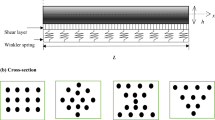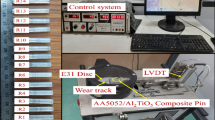Abstract
In this paper, a unidirectional carbon-fiber composite is both experimentally and numerically investigated to study the nonlinear material behavior of impacted double cantilever beam (DCB) specimens. For the impact analysis, the load and the displacement applied from pin onto end block as well as the crack energy release rate are measured and compared with the finite element analysis results. The energy release rate is a critical measure of the resistance to crack propagation, which can be estimated by the force and displacement at the crack tip. It is found that the energy release rate measured from impact tests on the specimens is well predicted by the finite element model suggested in this study.
Similar content being viewed by others
References
I. Norio, Y. Kejian and S. Akenori, Dynamic nonlinear analysis of reinforced concrete shear wall by finite element method with explicit analytical procedure,Earthquake Engineering & Structural Dynamics. 26(9) (1997) 967–986.
S. B. Biner, A finite element method analysis of the role of interface behavior in the creep rupture characteristics of a discontinuously reinforced composite with sliding grain boundaries,Materials Science & Engineering. Properties, Microstructure and Processing. A, Structural Materials. 208(2) (1996) 239–248.
B. R. K. Blackman, J. P. Dear, A. J. Kinloch, H. MacGillivray, Y. Wang, J.G. Williams and P. Yayla, Failure of fiber composites and adhesively bonded fiber composites under high rates of test part III mixed-mode I/II and mode II loadings,Journal of Materials Science. 31 (17) (1996) 4467–4477.
M. Kawai and Y. Masuko, Creep behavior of unidirectional and angle-ply T800H/3631 laminates at high temperature and simulations using a phenomenological viscoplasticity model,Composites Science and Technology. 64(15) (2004) 2373–2384.
X. J. Yang, Constitutive description of temperature-dependent nonproportional cyclic viscoplasticity,Journal of Engineering Materials and Technology. 119(1) (1997) 12–19.
A. S. Chen, D. P. Almond and B. Harris, Impact damage growth in composites under fatigue conditions monitored by acoustography,International Journal of Fatigue. 24(2/4) (2002) 257–261.
I. Georgiou, A. Ivankovic, A. J. Kinloch and V. Tropsa, Rate dependent fracture behaviour of adhesively bonded joints,Fracture of Polymers, Composites and Adhesives. (2003) 317–328.
A. Tabiei, W. Yi and R. Goldberg, Non-linear strain rate dependent micro-mechanical composite material model for finite element impact and crash worthiness simulation,International Journal of Non-linear Mechanics. 40(7) (2005) 957–970.
International Standards Organisation, ISO 11343 (ISO, Geneva) (1993).
ABAQUS Manual, Version 6.6, Karlsson and Sorensen Inc. (2006).
B. R. Blackman, J. P. Dear, A. J. Kinloch, H. Macgillivray, The faliure of fiber composites and adhesively bonded fiber composites under high rates of test,Journal of Materials Science. 30 (1995) 5885–5900.
B. R. Blackman, A. J. Kinloch and J. G. Williams, The failure of fiber composites and adhesively bonded fiber composites under high rates of test. part 3,Journal of Material Science. 31 (1996) 4467–4477.
J. G. Williams, End corrections for orthotropic DCB specimens,Compos Sci Technol. 35 (1989) 367–376.
J. G. Williams, Large displacement and end block effects in the DCB interlaminar test in modes I & II,Journal of Compos Mater. 21 (1987) 330–347.
E. F. Rybicki and M. F. Kanninen, A finite element calculation of stress intensity factors by a modified crack closure integral,Engineering Fracture Mechanics. 9 (4) (1977) 753–976.
Author information
Authors and Affiliations
Corresponding author
Rights and permissions
About this article
Cite this article
Cho, J.U., Lee, S.K., Cho, C. et al. A study on the impact behavior of adhesively-bonded composite materials. J Mech Sci Technol 21, 1671–1676 (2007). https://doi.org/10.1007/BF03177392
Received:
Revised:
Accepted:
Issue Date:
DOI: https://doi.org/10.1007/BF03177392




